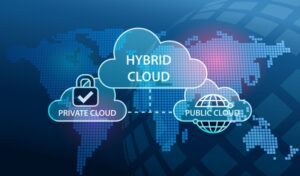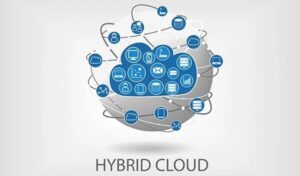A hybrid cloud environment combines on-premises infrastructure, private cloud services, and a public cloud, the hybrid cloud providers such as Amazon Web Services (AWS) or Microsoft Azure, with orchestration across multiple platforms. You have a hybrid cloud infrastructure if you use a mixture of public clouds, on-premises computing, and private clouds in your data centre.
We recognise the significance of hybrid cloud in cloud computing and their role in organisational development. In this blog article, we’ll go through the top five characteristics that define powerful and practical hybrid cloud computing.

What is Hybrid cloud computing?
A hybrid cloud computing approach combines a private cloud (or on-premises data centre) with one or more public cloud products connected by public or private networks (Tariq, 2018). Consistent operations enable the public cloud to serve as an extension of a private or on-premises system, with equivalent management processes and tools. Because nearly no one nowadays relies only on the public cloud, hybrid cloud computing options are becoming increasingly popular. Over the last few decades, companies have spent millions of dollars and thousands of hours on on-premises infrastructure. Combining a public and private cloud environment, such as an on-premises data centre, and a public cloud computing environment, hybrid cloud providers such as AWS, Microsoft Azure and Google Cloud, is the most typical hybrid cloud example.
Hybrid Cloud Providers
With the introduction of cloud computing into the current system, the digital revolution has radically changed the IT sector. There are several hybrid cloud providers on the market, including-
1. Amazon Web Services (AWS)
2. Microsoft Azure
3. Google Cloud
4. VMware
5. VMware Cloud on AWS, VMware Cloud on Dell EMC, HCI powered by VMware vSAN, and VMware vRealize cloud management
6. Rackspace
7. Red Hat OpenShift
8. Hewlett Packard Enterprise
9. Cisco HyperFlex solutions
10. Nife Cloud Computing

Characteristics of Hybrid Cloud Computing
The top 5 characteristics of Hybrid cloud computing:
Characteristic #1: Speed
The capacity to automatically adjust to changes in demand is a critical component in both innovation and competitiveness. The market is impatient and expects updates from you right now. Furthermore, your rival is optimising at a rapid pace, giving your business little time to adapt. As a result, Hybrid computing must be quick and portable, with maximum flexibility. This is achievable by hybrid cloud providers such as IBM Bluemix and newer technologies like Docker, which optimise programmes in a virtualized environment.
Characteristic #2: Cost Reduction
Lowering expenses is one of the advantages of going to the cloud. Purchasing IT assets in the past meant paying for what you didn’t utilise, which ate into the bottom line. Hybrid computing combines the best of both worlds, lowering IT costs while allowing enterprises to pay only for what they use. Choosing a hybrid cloud provider that optimises cost frees up more funding for innovation and bringing a product to market (Lee, 2019). We believe that switching to a hybrid cloud in cloud computing can save enterprises up to 30%.
Characteristic #3: Intelligent Capabilities and Automation
Creating a digital experience in the hybrid cloud in cloud computing necessitates the integration of various technologies, which presents a challenge for DevOps businesses that have traditionally relied on a plethora of tools to get the job done (Aktas, 2018). Leveraging intelligent, unified, and centralised management capabilities allow teams to be more productive and flexible in their daily tasks in modern enterprises. Hybrid computing not only reduces overall expenses but also accelerates application creation and deployment.
IT automation is crucial for IT businesses, especially when considering hybrid computing scalability. Automation in emerging and current contexts decreases the risk of human mistakes, enables prescriptive policy enforcement, lays the groundwork for predictive maintenance, and encourages cultural shifts toward time-saving, self-service habits.
Characteristic #4: Security
Hybrid computing provides organisations with critical control over their data as well as increased security by decreasing data exposure. Enterprises can decide where to store their data and workloads depending on compliance, regulatory, or security concerns. In addition, the hybrid architecture enables security teams to standardise redundant cloud storage, which is critical for disaster recovery and data insurance. The centralised administration of hybrid cloud in cloud computing also makes it easy to integrate strong technological security features like encryption, automation, access control, orchestration, and endpoint security to efficiently manage risk (Gordon, 2016).
Characteristic #5: Lightweight Applications
The final characteristic explores the size of the application. DevOps teams must develop and manage agile apps that load quickly, boost efficiency, and take up little space in the hybrid cloud in cloud computing (Diaby and Rad, 2017). Though storage is cheap, the emphasis should be on storing, understanding, and managing client data. DevOps profits from hybrid cloud computing while continuing to create for the future to integrate applications, participate in the global market, and maximize their technological demands.

References
Aktas, M.S. (2018). Hybrid cloud computing monitoring software architecture. Concurrency and Computation: Practice and Experience, 30(21), p.e4694. doi:10.1002/cpe.4694.
Diaby, T. and Rad, B.B. (2017). Cloud computing: a review of the concepts and deployment models. International Journal of Information Technology and Computer Science, 9(6), pp.50-58.
Gordon, A. (2016). The Hybrid Cloud Security Professional. IEEE Cloud Computing, 3(1), pp.82–86. doi:10.1109/mcc.2016.21.
Lee, I. (2019). An optimization approach to capacity evaluation and investment decision of hybrid cloud: a corporate customer’s perspective. Journal of Cloud Computing, 8(1). doi:10.1186/s13677-019-0140-0.
Tariq, M.I. (2018). Analysis of the effectiveness of cloud control matrix for hybrid cloud computing. International Journal of Future Generation Communication and Networking, 11(4), pp.1-10.
Read more on Hybrid Cloud Computing : https://blogs.nife.io/all-you-need-to-know-about-hybrid-cloud-deployment/






